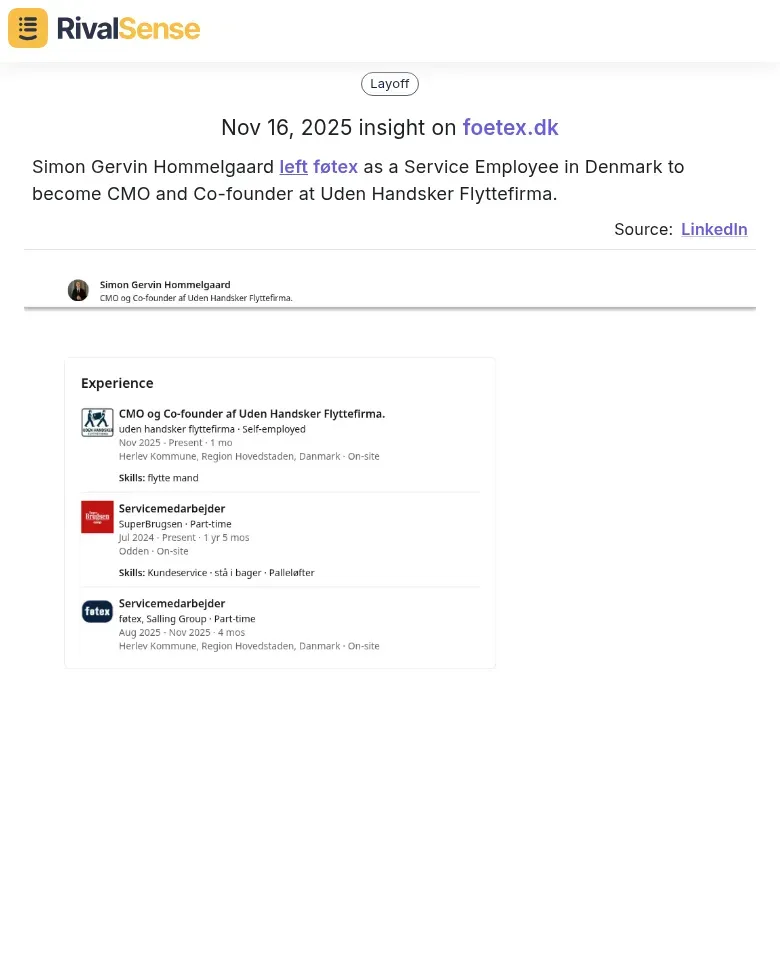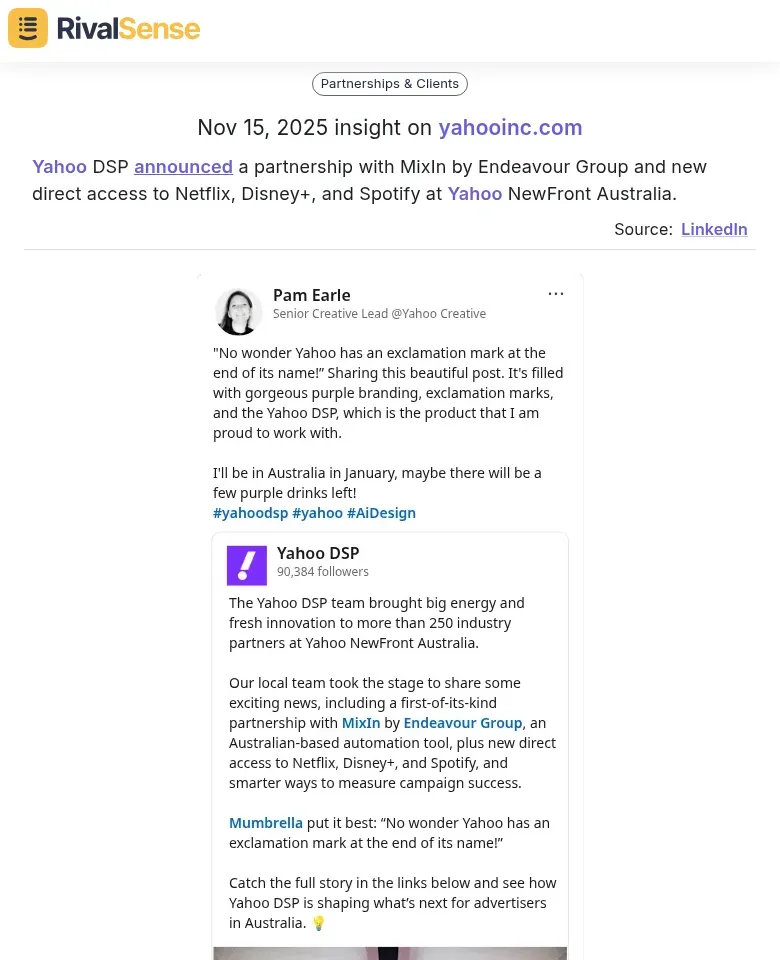Competitor Product Update Analysis: Your Practical Guide to Staying Ahead
By Simone Somekh, November 17, 2025
TABLE OF CONTENTS
- Key Takeaways
- What is Competitor Product Update Analysis?
- Why Tracking Product Updates Matters
- The Manual Approach: Step-by-Step Process
- How AI Transforms Update Analysis
- Practical Checklist for Product Update Monitoring
- Integrating Update Analysis into Your Strategy
- Real-World Examples
- Conclusion
- Frequently Asked Questions
KEY TAKEAWAYS
- 95% of new products fail – competitor update analysis helps you avoid this fate by learning from others' successes and failures
- Manual monitoring is time-consuming – tracking updates across websites, social media, and registries can take 10+ hours weekly
- AI-powered tools automate the process – providing comprehensive coverage across 80+ data sources
- Weekly insights are crucial – product landscapes change rapidly, requiring regular monitoring
- Practical implementation matters – use our downloadable checklist to implement immediately
WHAT IS COMPETITOR PRODUCT UPDATE ANALYSIS?
Competitor product update analysis is the systematic process of tracking and evaluating changes in your competitors' product offerings, features, pricing, and positioning. This dynamic approach provides ongoing intelligence rather than static snapshots, enabling businesses to stay agile and responsive in fast-moving markets.
Why it's different from traditional analysis:
- Tracks evolution rather than current state
- Identifies trends and patterns in product development
- Provides early warning signals of market shifts
- Helps anticipate competitor moves before they impact your business
WHY TRACKING PRODUCT UPDATES MATTERS
When a competitor launches a new feature or changes pricing, it directly impacts your market position. Staying informed about these changes enables proactive decision-making and strategic alignment. Tracking these updates helps you:
- Respond proactively rather than reactively
- Identify feature gaps in your own offerings
- Understand pricing strategies and market positioning
- Spot emerging trends before they become mainstream
Learning from Competitor Experiments
Competitors often test new approaches through product updates. By analyzing these experiments, you can:
- Avoid costly mistakes – learn what doesn't work without spending your own resources
- Accelerate innovation – build on successful competitor innovations
- Identify market opportunities – spot underserved customer segments
Practical Impact Examples
- SaaS companies can track feature releases to understand development priorities
- E-commerce businesses can monitor pricing changes and promotional strategies
- Hardware manufacturers can analyze product refreshes and component upgrades
THE MANUAL APPROACH: STEP-BY-STEP PROCESS
Manually tracking product updates requires a disciplined and consistent approach. While time-consuming, a structured manual process can yield valuable insights if executed regularly. Here's how to implement it effectively.
Step 1: Identify Your Tracking Targets
Actionable Checklist:
- [ ] List top 3-5 direct competitors
- [ ] Include 2-3 indirect competitors (companies solving similar problems differently)
- [ ] Add 1-2 emerging startups in your space
- [ ] Note key product lines and SKUs for each
Step 2: Establish Monitoring Channels
Practical Implementation:
Website Monitoring:
- Bookmark competitor product pages and check weekly
- Use browser extensions to track page changes
- Monitor career pages for hiring patterns (indicates new initiatives)
Social Media Tracking:
- Follow competitor company accounts
- Set up Google Alerts for competitor names + "launch" or "update"
- Monitor relevant hashtags and industry discussions
Review Site Monitoring:
- Check G2, Capterra, Trustpilot weekly
- Look for new feature mentions in recent reviews
- Track review volume and sentiment changes
Step 3: Document and Analyze Changes
Create Your Update Tracking Spreadsheet:
| Competitor | Date | Update Type | Details | Impact Assessment | Your Response |
|---|---|---|---|---|---|
| Competitor A | Nov 15 | Feature Launch | New AI integration | High - matches our roadmap | Accelerate development |
| Competitor B | Nov 10 | Price Change | 15% increase | Medium - creates pricing gap | Consider premium positioning |
Step 4: Regular Review and Action
Weekly Process:
- Collect all update information
- Categorize by type (feature, pricing, positioning, etc.)
- Assess impact on your business
- Determine required actions
- Update your product roadmap accordingly
HOW AI TRANSFORMS UPDATE ANALYSIS
Manually tracking product updates across multiple competitors is nearly impossible due to the sheer volume of data. AI-powered tools automate this process, providing comprehensive and timely insights that manual methods often miss.
The Scale Problem
Most businesses face significant challenges with manual monitoring:
- Miss 60-70% of relevant updates
- Spend 10-15 hours weekly on manual monitoring
- Receive information too late to act effectively
AI-Powered Solutions
Tools like RivalSense solve this by automatically tracking competitor activities across 80+ data sources, including:
- Company websites and product pages
- Social media platforms and discussions
- Industry registries and regulatory filings
- Review sites and customer forums
- News outlets and press releases
Key Benefits:
- Comprehensive coverage – no missed updates
- Real-time alerts – immediate notification of changes
- Structured analysis – organized weekly reports
- Trend identification – pattern recognition across multiple updates
PRACTICAL CHECKLIST FOR PRODUCT UPDATE MONITORING
Implementing a systematic monitoring process is crucial for consistent insights. Use this checklist to ensure you cover all essential aspects and maintain a competitive edge.
✅ Setup Phase
- [ ] Identify 5-8 key competitors to track
- [ ] Create dedicated tracking spreadsheet
- [ ] Set up Google Alerts for each competitor
- [ ] Follow competitors on relevant social platforms
- [ ] Bookmark key product pages
✅ Weekly Monitoring Tasks
- [ ] Review competitor websites for changes
- [ ] Check social media for announcements
- [ ] Scan review sites for new feature mentions
- [ ] Monitor industry news and blogs
- [ ] Update tracking spreadsheet
✅ Monthly Deep Dive
- [ ] Analyze update patterns and trends
- [ ] Compare competitor roadmaps
- [ ] Assess impact on your product strategy
- [ ] Update competitive positioning
- [ ] Share insights with product team
✅ Quarterly Strategy Review
- [ ] Evaluate overall competitive landscape
- [ ] Identify emerging threats and opportunities
- [ ] Adjust product roadmap based on insights
- [ ] Review and update monitoring priorities
INTEGRATING UPDATE ANALYSIS INTO YOUR STRATEGY
Integrating competitor insights into your strategy transforms data into actionable plans. Regularly reviewing updates helps align your product development and marketing efforts with market dynamics.
Product Development
Use competitor updates to:
- Validate feature priorities – if multiple competitors add similar features, it indicates market demand
- Identify innovation opportunities – look for gaps in competitor offerings
- Accelerate development – learn from competitor technical approaches
Pricing Strategy
Track competitor pricing changes to:
- Maintain competitive positioning
- Identify premium opportunities
- Understand value perception in the market
Marketing and Positioning
Analyze how competitors position updates to:
- Refine your messaging
- Identify unique value propositions
- Understand customer pain points being addressed
REAL-WORLD EXAMPLES
Seeing how other businesses leverage competitor update analysis can illustrate its practical benefits. Here are examples from different industries, including real insights from RivalSense.
SaaS Company Example
Scenario: A project management software company tracking competitor updates
Manual Approach:
- Weekly website checks: 2 hours
- Social media monitoring: 3 hours
- Review site scanning: 2 hours
- Documentation and analysis: 3 hours
- Total: 10 hours weekly
AI-Powered Approach (RivalSense):
- Automated tracking across all sources
- Weekly email report with all updates
- Analysis time: 1 hour weekly
- Time saved: 9 hours weekly
Impact: The company identified a competitor's new AI feature early, accelerated their own development, and launched a superior version within 3 months, gaining significant market share.
E-commerce Example
Scenario: An electronics retailer tracking competitor pricing and product updates
Insights Gained:
- Competitor A consistently lowers prices 2 weeks before major holidays
- Competitor B adds new features to existing products every 6 months
- Competitor C uses limited-time promotions to test new pricing strategies
Strategic Actions:
- Adjusted holiday pricing strategy
- Accelerated feature development cycle
- Implemented controlled pricing experiments
RivalSense Insights in Action
Here are real examples of competitor updates tracked by RivalSense, showing how different types of insights can inform your strategy.
Product Update Example: Platinum Credit

Platinum Credit has increased its maximum loan duration from 96 months to 120 months and the maximum loan amount from Kes. 2,000,000 to Kes. 5,000,000.
Why it's valuable: Tracking product updates like this helps you understand competitor expansion strategies and identify gaps in your own offerings. For instance, if a competitor increases loan limits, it might indicate growing customer demand for higher amounts, prompting you to review your product features.
Management Change Example: Simon Gervin Hommelgaard

Simon Gervin Hommelgaard left føtex as a Service Employee in Denmark to become CMO and Co-founder at Uden Handsker Flyttefirma.
Why it's valuable: Management changes can signal strategic shifts or new initiatives. For example, a key hire in a leadership role might indicate a focus on marketing or expansion, allowing you to anticipate competitor moves and adjust your strategy accordingly.
Partnership Announcement Example: Yahoo DSP

Yahoo DSP announced a partnership with MixIn by Endeavour Group and new direct access to Netflix, Disney+, and Spotify at Yahoo NewFront Australia.
Why it's valuable: Partnership updates reveal collaboration strategies that can enhance product offerings. This insight helps you understand how competitors are leveraging alliances to reach new markets or integrate features, informing your own partnership decisions and competitive positioning.
CONCLUSION
Competitor product update analysis is no longer a nice-to-have – it's a critical component of modern business strategy. By adopting systematic tracking methods, businesses can stay ahead of market shifts and capitalize on opportunities effectively.
The companies that consistently track and respond to competitor moves gain significant advantages in:
- Market positioning
- Product development
- Pricing strategy
- Customer acquisition
While manual monitoring provides some insights, the scale and speed of modern business require automated solutions. Tools like RivalSense that track updates across 80+ sources and deliver weekly comprehensive reports transform this from a time-consuming chore into a strategic advantage.
Next Steps:
- Use the practical checklist in this article to start monitoring
- Implement weekly reviews to stay current
- Consider automated solutions for comprehensive coverage
- Integrate insights into your product planning process
Ready to transform your competitor tracking? Try RivalSense for free at https://rivalsense.co/ and get your first competitor report today to gain actionable insights and stay ahead of the competition.
FREQUENTLY ASKED QUESTIONS
How often should I check for competitor updates?
Weekly monitoring is essential, as product landscapes can change rapidly. Monthly reviews are insufficient for staying competitive in fast-moving markets.
What's the biggest mistake companies make in update analysis?
Focusing only on direct competitors and missing emerging threats from adjacent markets or new startups.
How can small teams with limited resources conduct effective update analysis?
Start with 2-3 key competitors and use automated tools like RivalSense to handle the heavy lifting of data collection and monitoring.
What metrics should I track beyond feature updates?
Pricing changes, positioning shifts, customer sentiment changes, hiring patterns, and partnership announcements all provide valuable insights.
How do I know if an update is significant enough to warrant action?
Evaluate based on: customer impact, strategic alignment with your business, resource requirements for response, and potential market share impact.
📚 Read more
👉 Mastering Real-Time Competitor Alerts in Cloud Infrastructure
👉 How RivalSense Enabled Competitors to Counter Folksam's Market Moves
👉 Instagram Competitor SWOT Analysis: Uncover Strategic Insights
